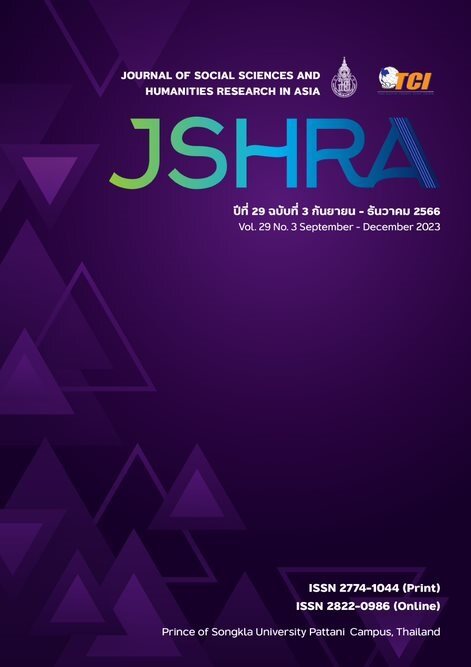Developing Low - carbon Homestays in Ban Tham Sua Using the Analytic Hierarchy Process (AHP)
Keywords:
Analytic Hierarchy Process (AHP), Homestays, Low - carbon, Policy and Waste Management, Water and Energy Management, , Tourism Activity and TransportationAbstract
This study aimed at investigating the factors influencing the establishment of low-carbon homestays and provide guidelines for this type of lodging to guarantee the sustainability of homestays after the COVID-19 pandemic. Using those critical factors identified in the previous literature reviews, ten (10) stakeholders were interviewed within the context of homestays to gather data. Using the Analytical Hierarchy Process (AHP), the researchers entrusted the participants with identifying the crucial factors for the survival of their low-carbon homestays. Then the data analysis has allowed the researchers to figure out the relative importance of each factor. According to our findings, the establishment of low-carbon homestays in the Ban Tham Sua community can be divided into three primary categories. With a score of 66.65%, policy and waste management was the most significant factor, followed by water and energy management with a weightage of 24.07%. While tourism activity and transportation was the least significant factor with only a weightage of 9.29%. Hence, by using the aforementioned data, it is expected that the owners of homestays will be able to navigate critical factors and operate their businesses parallel with a low - carbon mindset in the future. In general, the results of this study will be beneficial for the stakeholders in the context of homestays or other types of accommodations, as they provide insights and guidelines regarding the vital critical factors in operating a successful low-carbon homestay.
References
Adedoyin, F.F., & Bekun, F.V. (2020). Modelling the interaction between tourism, energy consumption, pollutant emissions and urbanization: renewed evidence from panel VAR. Environmental Science and Pollution Research. 27, 38881 - 38900.
Arenhart, R.S., Souza, A.M., & Zanini, R.R. (2022). Energy use and its key factors in hotel chains. Sustainability, 14(4), 8239. https://doi.org/10.3390/su14148239
Baxter, G., & Srisaeng, A. (2021). An assessment of the environmentally sustainable hotel operation: The case of Centara hotels & resorts, Thailand. Journal of Sustainable Tourism Development, 3(2),1-33.
Bhaktikul, K., Aroonsrimorakot, S., Laiphrakpam, M., & Paisantanaki, W. (2021). Toward a low-carbon tourism for sustainable development: A study based on a royal project for highland community development in Chiang Rai, Thailand. Environment, Development and Sustainability, 23, 10743 - 10762.
Cavallaro, F., Galati, O.I., & Nocera, S. (2020). Climate change impacts and tourism mobility: A destination-based approach for coastal areas. International Journal of Sustainable Transportation, 15(6), 456 - 473.
Changbo, S., & Jingjing, P. (2011). Construction of low-carbon tourist attractions based on low - carbon economy. Energy Procedia, 5, 759 - 762.
Cheng, Q., Su, B., & Tan, J. (2013). Developing an evaluation index system for low-carbon tourist attractions in China - A case study examining the Xixi wetland. Tourism Management, 36, 314 - 320.
Choi, H., Jang, J., & Kandampully, J. (2015). Application of the extended VBN theory to Understand consumers’ decisions about green hotels. International Journal of Hospitality Management, 51, 87 - 95.
Claudia, C. (2016). Water act: A summary of the law. United States: Congressional Research Service.
Cole, M.A., & Neumayer, E. (2004). Examining the impact of demographic factors on air pollution. Retrieved October 29, 2020, from https://econwpa.ub.uni-muenchen.de/econ-wp/lab/papers/0312/0312005.pdf
Dong, Q., & Saaty, T.L. (2014). An analytic hierarchy process model of group consensus. Journal of Systems Science and Systems Engineering, 23, 362 - 374.
Downs, A., & Acevedo, R. (2022). Zero waste-its time has come. Pennsylvania: Transition Town Greater Media.
Eddine M.H., & Amara, S. (2021). Investigation and analysis of energy and water use of hotel buildings in Tunisia. Energy and Buildings, 241, 110930.
Energy Institute Team of P.R. China National Development and Reform Commission. (2009). The low-carbon development path to 2050 of P.R. China: Scenarios analysis of energy demand and carbon emissions. Beijing: Science Press.
Golden, B.L., & Wang, Q. (1990). Analytic hierarchy process: Applications and studies. New - York: Springer Verlag.
Gössling, S., Peeters, P., Hall, C.M., Ceron, J.P., Dubois, G., & Scott, D. (2012). Tourism and water use: Supply, demand, and security. An international review. Tourism Management, 33(1), 1 - 15.
Gössling, S. (2013). National emissions from tourism: An overlooked policy challenge? Energy Policy, 59, 433 - 442. https://doi.org/10.1016/j.enpol.2013.03.058
Gossling, S., & Peeters, P. (2015). Assessing tourism’s global environmental impact 1900 - 2050. Journal of Sustainable Tourism, 23(5), 639 - 659.
Gossling, S., Arana, J.E., & Aguiar-Quintana, J.T. (2019). Towel reuse in hotels: Importance of normative appeal designs. Tourism Management, 70(1), 273 - 283.
Gossling, S., & Lund-Durlacher, D. (2021). Tourist accommodation, climate change and mitigation: An assessment for Austria. Journal of Outdoor Recreation and Tourism, 34, 1 - 9.
Gulistan, A., Tariq, Y.B., & Bashir, M.F. (2020). Dynamic relationship among economic growth, energy, trade openness, tourism, and environmental degradation: Fresh global evidence. Environmental Science and Pollution Research, 27, 13477 - 13487.
Herring, D. (2020). Doesn't carbon dioxide in the atmosphere come from natural sources? Retrieved October 29, 2020, from https://www.climate.gov/news-features/climate-qa/doesnt-carbon-dioxide-atmosphere-come-natural-sources
Hoogendoorn, G., & Fitchett, J.M. (2016). Tourism and climate change: A review of threats and adaptation strategies for Africa. Current Issue in Tourism, 21(7), 742 - 759.
Hussin, F., Aroua, M.K., Kassim, M.A., & Md. Ali, U.F. (2021). Transforming plastic waste into porous carbon for capturing carbon dioxide: A review. Energies, 14(24), 8421. https://doi.org/10.3390/en14248421
International Energy Agency. (2017). Energy policies and sustainable management of energy resource. Retrieved October 29, 2023, from https://www.iea.org/
Intergovernmental Panel on Climate Change (IPCC). (2014). Climate change 2014: Synthesis report. contribution of working groups i, ii and iii to the fifth assessment report of the intergovernmental panel on climate change. ipcc, geneva, switzerland. Retrieved October 29, 2023, from http://www.ipcc.ch/pdf/assessment-report/ar5/syr/SYR_AR5_LONGERREPORT.pdf
Khanal, A., & Rahman, M.M. (2021). Are tourism and energy consumption linked? Evidence from Australia. Sustainability, 13(19), 10800.
Kim, S., Filimonau, V., & Dickinson, J.E. (2020). The technology - evoked time use rebound effect and its impact on pro-environmental consumer behaviour in tourism. Journal of Sustainable Tourism, 28(2), 164 - 184. https://doi.org/10.1080/09669582.2019.1643870
Koiwanit, J., & Filimonau, V. (2021). Carbon footprint assessment of home-stays in Thailand. Resources, Conservation and Recycling, 164, 105123. https://doi.org/10.1016/j.resconrec.2020.105123
Make Wealth History. (2015). Carbon footprints. Retrieved October 29, 2023, from http://makeweal
thhistory.org/2008/04/08/carbon-footprints-what-makes-the-biggest-difference/
McDaniel, M., Sprout, E., Boudreau, D., & Turgeon, A. (2019). Pollution. National geographic. Retrieved October 29, 2023, from https://www.nationalgeographic.org/encyclopedia/pollution/
McLennan, M.R., Spagnoletti, N., & Hockings, K.J. (2017). The implications of primate behavioral flexibility for sustainable human - primate coexistence in anthropogenic habitats. International Journal of Primatology, 38, 105 - 121.
Nejat, P., Jomehzadeh, F., Taheri, M.M., Gohari, M., & Majid, M.Z.A. (2015). A global review of energy consumption, CO2 emissions and policy in the residential sector (with an overview of the top ten CO2 emitting countries). Renewable and Sustainable Energy Reviews, 43, 843 - 862.
Nguyen, A.T., & Rockwood, D. (2019). Developing an energy benchmarking system for hotel buildings using the statistical method and the simulation - based approach. Journal of Green Building, 14(3), 1 - 22.
Penner, R.H., Adams, L., & Robson, S.K.A. (2013). Hotel design, planning and development (2nd ed.). Oxon: Routledge.
Pensiri, A., Nantaporn, K., & Parichut, P. (2016). The study of tourists’ behavior in water usage in hotel business: Case study of Phuket Province, Thailand. International Journal of Industrial and Systems Engineering, 10(10), 3336 - 3370.
Pickering, C.M., & Hill, W. (2007). Impacts of recreation and tourism on plant biodiversity and vegetation in protected areas in Australia. Journal of Environmental Management and Tourism, 85(4), 791 - 800.
Rico, A., Martínez-Blanco, J., Montlleó, M., Rodríguez, G., Tavares, N., Arias, A., & Oliver-Solà, J. (2019). Carbon footprint of tourism in Barcelona. Tourism Management, 70, 491 - 504.
Saaty, T.L. (2008). Decision making with the analytic hierarchy process. International Journal of Services Sciences, 1(1), 83 - 98.
Stefănică, M., Sandu, C.B., Butnaru, G.I., & Haller, A.-P. (2021). The nexus between tourism activities and environmental degradation: Romanian tourists’ opinions. Sustainability, 13(16), 9210.
Su, J. (2019). Impact of tourism resource development based on low-carbon mode: A case study of Guizhou ethnic areas. Ecological processes, 8(1), 1 - 7.
Taherdoost, H. (2017). Determining sample size; How to calculate survey sample size. International Journal of Economics and Management Systems, 2, 1 - 3.
Tsai, K.T., Lin, T.P., Hwang, R.L., & Huang, Y.J. (2014). Carbon dioxide emissions generated by energy consumption of hotels and homestay facilities in Taiwan. Tourism Management, 42, 13 - 21.
United Nations Economic Commission for Europe (UNECE). (2022). Carbon neutrality in the UNECE region: Integrated life-cycle assessment of electricity sources. Retrieved December 18, 2023, from https://unece.org/sites/default/files/2022-04/LCA_3_FINAL%20March%202022.pdf
Vatan, A., & Yilmaz, Z. (2020). New ceramic solutions in sustainable hotels within the scope of sustainable innovation. In V. Ratten (Ed.), Entrepreneurial opportunities (pp.147-163). Emerald Publishing Limited.
Velazquez, L., Munguia, N.E., Will, M., Zavala, A.G., Verdugo, S.P., Delakowitz, B., & Giannetti, B. (2015). Universidad de Sonora, departamento de ciencias químico - biológicas. Management of Environmental Quality: An International Journal, 16, 373 - 388.
Wang, Q., Mao, Z., Xian, L., & Liang, Z. (2019). A study on the coupling coordination between tourism and the low-carbon city. Asia Pacific Journal of Tourism Research, 24(6), 550 - 562.
Warren, C., & Becken, S. (2017). Saving energy and water in tourist accommodation: A systematic literature review. International Journal of Tourism Research, 19(3), 289 - 303.
World Travel and Tourism Council (2023). Economic Impact Reports. Retrieved October 29, 2023, from https://wttc.org/Research/Economic-Impact
Xu, X., Yang, H., & Li, C. (2022). Theoretical model and actual characteristics of air pollution affecting health cost: A review. International Journal of Environmental Research and Public Health, 19(6), 3532. http://doi:10.3390/ijerph19063532
Yadegaridehkordi, E., Shuib, L., Nilashi, M., & Asadi, S. (2019). Decision to adopt on-line collaborative learning tools in higher education: A case of top Malaysian universities. Education and Information Technologies, 24(1), 79 - 102.
Zhang, J., & Zhang, Y. (2020). Assessing the low-carbon tourism in the tourism-based urban destinations. Journal of Cleaner Production, 276, 124303. https://doi.org/10.1016/j.jclepro.2020.124303











